This month’s guest blogger is Chrissa Pagitsas (MBA ’09). In her career over the last two decades, Pagitsas led ambitious environmental, social and governance (ESG) and sustainability strategies for commercial real estate and financial services companies. She founded and led the market-transforming $50 billion Green Bond business and ESG strategies at Fannie Mae.
Pagitsas’ experiences helped inform her new book, Chief Sustainability Officers at Work, which includes insights from 25 chief sustainability officers and heads of ESG at Fortune 500 companies. The book considers ESG strategies at global companies and delves into the unique leadership skills these executives possess. Pagitsas now advises global companies and philanthropies on how to lead impactful ESG strategies that also drive business value. She recently shared the insights below:
Do you want to write a book about your business experience? A book is a great way to teach hard-won lessons. But many business leaders struggle to translate enthusiasm into a finished manuscript. Here are the five steps that brought my book, Chief Sustainability Officers At Work, from concept to printed book and best seller.
1. Begin with the end in mind.
There are many business books in the market read by millions of businesspeople globally. Yet, “business” is such a large category. Your end goal is to reach the target reader who will most value your book’s message. They may only number in the hundreds or thousands. Therefore, begin by concretely defining the reader. Ask yourself, what career stage is the reader in — beginning, middle, end? Does the reader work within a specific industry or role? What urgent problem will you resolve for them? My primary reader is the sustainability leader who must partner with or influence “non-sustainability” board members and senior executives — the secondary reader.
With your target reader narrowed, map your book’s sales process. How and when will the book land in your reader’s hands? Where do they learn about books — from social media, conferences or book reviews? Linking the target reader and the sales process prepares you for step No. 2.
2. Get anchored in your thesis statement.
Capture your book succinctly for publishers and clients with a strong thesis statement, just as a 30-second elevator pitch highlights your professional strengths. The thesis should capture what your book is exploring and the urgency of why it needs to be written. It will also serve as an anchor that you can hold on to when buffeted by too many differing opinions and research. However, do test your thesis with your target reader and thoughtfully adjust if needed.
My book’s thesis is “Chief sustainability officers and heads of ESG possess unique leadership and technical skills that allow them to build successful sustainability and ESG strategies for their global companies.” It’s anchored on the success factors to leading sustainability from the C-suite. What’s your thesis statement?
3. Your strengths are your secret weapon.
Rely on your strengths as a business leader to write your book; no advanced degree in writing is needed. Two of my strengths are breaking down a big goal into smaller, executable steps and public speaking. “Write a 24-chapter book in 12 months” became manageable once I identified 14 steps to be repeated for each chapter, from interviewing the sustainability executives to addressing the publisher’s critiques and resolving copyedits. A spreadsheet with the 336 tasks kept me focused — and showed tangible proof of progress when I marked a task as completed. When it came to writing the preface, a Darden classmate lobbed questions at me, and I pretended I was answering them on a conference stage. I recorded the session, and the resulting transcript was the preface’s first draft. If you’re great at writing short memos, write 10 of them. If you’re great at one-on-one conversations, try a book in Q&A format. There’s no one right way to “write” a book.
4. Build your support team.
Behind every Olympic downhill skier and marathoner, there is a team of coaches, nutritionists and psychologists. As an author, you also should build a trusted support team. They will help you cross your finish line: a completed book. My team included a development editor who constructively found logic holes in my writing, Darden classmates who used their knowledge as marketers to craft my book’s marketing strategy, and my sister who dispelled my doubts about my book’s thesis. Don’t be shy about hiring a book writing coach, copyeditor or indexer. Lean on friends to pull you out of the inevitable quicksand of doubt and fatigue even if they never read a chapter.
5. Have fun as you learn a new craft.
Ultimately, writing your first business book isn’t about writing. It’s about being open to learning new skills and keeping a sense of humor — over many months to years! I learned to synthesize a career of two decades into two pages, a fantastic new skill. Yet I laugh now at how easy I thought it would be to create the book’s index. (I should have added a professional indexer to my support team.) Most valuably, I learned more about myself as a leader as I observed and wrote about other leaders.
The finished book itself will be an accomplishment, but your own experience writing it will be even greater.





